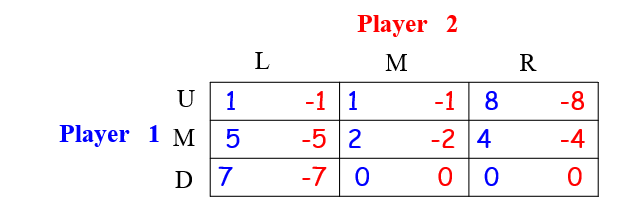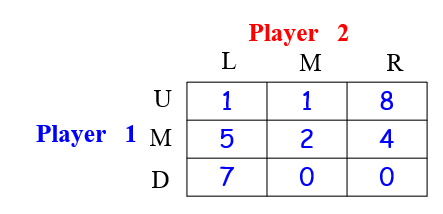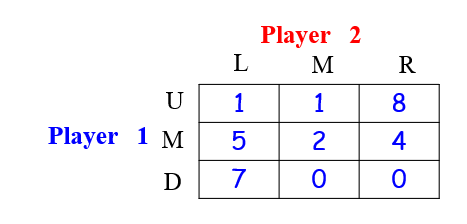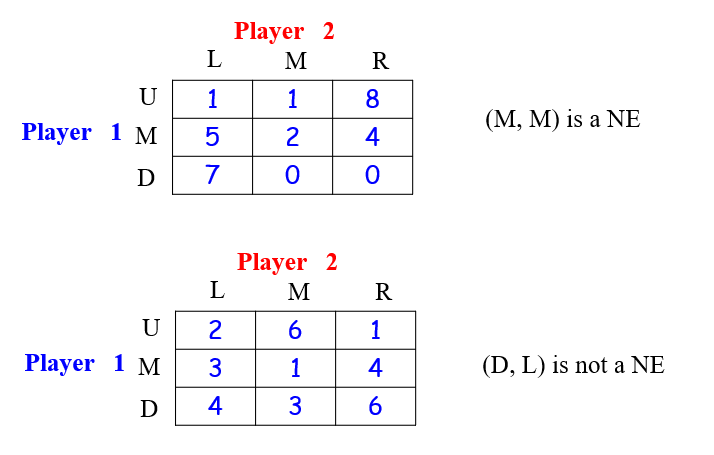[TOC]
4.1 定义
A two-player zero-sum game is a strategy game $ G = \{ \{ 1, 2 \}, \{ A_1, A_2 \}, \{ u_1, u_2 \} \} $ such that
One player wins while the other losses
4.1.1 举例

- 对于两人的零和博弈,约定考虑第一个人的收益矩阵,缩略图如下

- $ u(a_1, a_2)$即为第一个人的收益矩阵
4.1.2 Maxmin (最大化最小原则例子)
Player 1 method: $\max_{a_1 \in A_1} \min_{a_2 \in A_2} \, u(a_1, a_2)$
Player 1 selects M: $ M \in \arg\max_{a_1 \in A_1} \min_{a_2 \in A_2} u(a_1, a_2) $
- $a_1=U$ ,$a_2$会最小化收益,因此收益1
- $a_1=M$ ,$a_2$会最小化收益,因此选择2
- $a_1=D$ ,$a_2$会最小化收益,因此选择0
最大化选择,因此选择M
Player 2 method: $ \max_{a_2 \in A_2} \min_{a_1 \in A_1} \, u_2(a_1, a_2)$
Player 2 selects M
- 在这个情况下,Player 2的收益矩阵相当于Player 1的收益矩阵全部取负值
- $a_2=L$ ,$a_1$会最小化收益,因此收益-7
- $a_2=M$ ,$a_1$会最小化收益,因此选择-2
- $a_2=R$ ,$a_1$会最小化收益,因此选择-8
最大化选择,因此选择M
4.2 Minmax (最小化最大原则)
Player 2 method: $ \max_{a_2 \in A_2} \min_{a_1 \in A_1} u_2(a_1, a_2) $
From $ u_2(a_1, a_2) = -u(a_1, a_2) $, we have
$ \max_{a_2 \in A_2} \min_{a_1 \in A_1} u_2(a_1, a_2) = \max_{a_2 \in A_2} \min_{a_1 \in A_1} (-u(a_1, a_2)) $
By $ \max(-f(x)) = -\min(f(x)) $, we get
$ \max_{a_2 \in A_2} \min_{a_1 \in A_1} u_2(a_1, a_2) = -\min_{a_2 \in A_2} \max_{a_1 \in A_1} u(a_1, a_2) $
Player 2 method: $ \arg\min_{a_2 \in A_2} \max_{a_1 \in A_1} u(a_1, a_2) $
4.2.1 例1
还是上文的例子:Player 2 method: $ \min_{a_2 \in A_2} \max_{a_1 \in A_1} \, u_2(a_1, a_2)$

- $a_2=L$ ,$a_1$会最大化收益,因此收益7
- $a_2=M$ ,$a_1$会最大化收益,因此选择2
- $a_2=R$ ,$a_1$会最大化收益,因此选择8
最小化选择,因此仍旧选择M
在这里我们发现两个player的选择:
$ \min_{a_2 \in A_2} \max_{a_1 \in A_1} \, u_2(a_1, a_2)$=$\max_{a_1 \in A_1} \min_{a_2 \in A_2} \, u(a_1, a_2)$
4.2.2 例2

$ \min_{a_2 \in A_2} \max_{a_1 \in A_1} \, u_2(a_1, a_2)$>$\max_{a_1 \in A_1} \min_{a_2 \in A_2} \, u(a_1, a_2)$
- Player 1:3
- Player 2:4
4.2.3 MinMax ≥ MaxMin
Lemma: For a two-player zero-sum finite game $ G $, we have
Proof: For any function $ F(x, y) $, we have
- 实际上对于任何一个问题都有minmax$\geq$maxmin
4.3 Two-Players Zero-Sum Nash Equilibrium
Theorem: For a two-player zero-sum finite game $ G = \{ \{1, 2\}, \{A_1, A_2\}, u \} $, let player 1 select
and let player 2 select
The strategy outcome $(a_1^, a_2^)$ is a Nash Equilibrium if and only if
4.3.1 Proof
Necessity:
要证明:
If $(a_1^, a_2^)$ is a NE, then
By using $u_1(\cdot, \cdot) = u(\cdot, \cdot)$ and $u_2(\cdot, \cdot) = -u(\cdot, \cdot)$, we have
If $(a_1^, a_2^)$ is a NE, then we have
Therefore,
结合
即可得到相等结果
Sufficiency:
要证明:
If $ \min_{a_2 \in A_2} \max_{a_1 \in A_1} u(a_1, a_2) = \max_{a_1 \in A_1} \min_{a_2 \in A_2} u(a_1, a_2), $=
then =$ u(a_1, a_2^) \leq u(a_1^, a_2). $
We have
and
Thus , $ u(a_1, a_2^) \leq u(a_1^, a_2)$, $(a_1^, a_2^)$ is a NE
4.3.2 Find Nash Equilibrium

4.4 Mixed strategy
Strategic game
$N = \{1, 2\}$
$A_1 = {a_1, a_2, \dots, a_m}$, $A_2 = {b_1, b_2, \dots, b_n}$
$u_1 (a_i, b_j) = u(a_i, b_j) = u_{ij}$, $M = (u_{ij})_{m \times n}$
Mixed strategy
$p = (p_1, p_2, \dots, p_m) \in \Delta_1$ is a mixed strategy over $A_1$
$q = (q_1, q_2, \dots, q_n) \in \Delta_2$ is a mixed strategy over $A_2$
The expected payoff for player 1 on mixed outcome $(p, q)$
$U(p, q) = \sum_{i, j} p_i q_j u(a_i, b_j) = \sum_{i, j} p_i q_j u_{ij} = p M q^{\top}$
Player 1’s methods:
$\max_{p \in \Delta_1} \min_{q \in \Delta_2} U_1(p, q) = \max_{p \in \Delta_1} \min_{q \in \Delta_2} p M q^{\top}$
Player 2’s methods:
$\max_{q \in \Delta_2} \min_{p \in \Delta_1} U_2(p, q) = \min_{q \in \Delta_2} \max_{p \in \Delta_1} p M q^{\top}$
Lemma
We have $\max_{p \in \Delta_1} \min_{q \in \Delta_2} U(p, q) \leq \min_{q \in \Delta_2} \max_{p \in \Delta_1} U(p, q)$
4.4.1 混合策略零和博弈的纳什均衡
Theorem:
For a two-player zero-sum finite game $G = \{ \{1, 2\}, \{A_1, A_2\}, u \}$, let player 1 select
and let player 2 select
The mixed strategy outcome $(p^, q^)$ is a Mixed Strategy Nash Equilibrium (MNE) if and only if
$\max_{p \in \Delta_1} \min_{q \in \Delta_2} U(p, q) = \min_{q \in \Delta_2} \max_{p \in \Delta_1} U(p, q).$
Proof
Maximization by Player 1: Player 1 seeks to maximize their minimum payoff by choosing a mixed strategy $p \in \Delta_1$. This means player 1 will select $p^* \in \arg \max_{p \in \Delta_1} \min_{q \in \Delta_2} p M q^\top$.
The objective is:
$\max_{p \in \Delta_1} \min_{q \in \Delta_2} p M q^\top.$
This represents the maximum of the minimum payoff player 1 can secure, considering that player 2 is choosing their strategy qq to minimize player 1’s payoff.
Minimization by Player 2: Similarly, player 2 aims to minimize their maximum loss, selecting $q^* \in \arg \min_{q \in \Delta_2} \max_{p \in \Delta_1} p M q^\top$.
The objective is:
$\min_{q \in \Delta_2} \max_{p \in \Delta_1} p M q^\top$.
This represents the minimum of the maximum payoff player 2 has to endure, considering that player 1 is choosing their strategy pp to maximize their payoff.
The Minimax Theorem: By the minimax theorem for zero-sum games, we know that the optimal strategies $p^ $and $q^$ for players 1 and 2, respectively, will lead to the following equality:
$\max_{p \in \Delta_1} \min_{q \in \Delta_2} p M q^\top = \min_{q \in \Delta_2} \max_{p \in \Delta_1} p M q^\top$.
This is the core of the minimax theorem, which ensures that the game has an equilibrium point in mixed strategies where both players are choosing their strategies optimally.
Conclusion: Since $p^$ and $q^$ satisfy the conditions of the minimax theorem, we conclude that the outcome of the game (given by $p^, q^$) will be a Mixed Strategy Nash Equilibrium (MNE). The equality
$\max_{p \in \Delta_1} \min_{q \in \Delta_2} p M q^\top = \min_{q \in \Delta_2} \max_{p \in \Delta_1} p M q^\top$
holds true, confirming that the mixed strategy outcome $(p^, q^)$ is indeed a Nash equilibrium.
4.4.2 General John von Neumann’s minimax theorem
The Minimax Theorem:
Let $X \subset \mathbb{R}^n$ and $Y \subset \mathbb{R}^m$ be compact convex sets.
If $f: X \times Y \to \mathbb{R}$ is a continuous function such that:
- $f(\cdot, y): X \to \mathbb{R}$ is concave for fixed $y$;
- $f(x, \cdot): Y \to \mathbb{R}$ is convex for fixed $x$,
then we have:
4.4.3 John von Neumann’s Minimax Theorem (1928)
The Minimax Theorem: For a two-player zero-sum finite game $G = \{ \{1, 2\}, \{A_1, A_2\}, u \}$, we have:
Corollary: Two-person finite zero-sum games have at least one mixed-strategy Nash equilibrium: any pair of optimal strategies is a Nash equilibrium.
4.4.4 Example

Player 1’s mixed strategy: $(x_1, x_2)$
$U_2 (L) = -3x_1 + 2x_2, \quad U_2 (R) = x_1 - x_2$
The optimal solution for Player 2 is:
$\max(-3x_1 + 2x_2, x_1 - x_2)$
The payoffs for Player 1 is:
$-\max(-3x_1 + 2x_2, x_1 - x_2) = \min(3x_1 - 2x_2, -x_1 + x_2)$
The solution for Player 1 is:
$(x_1, x_2) \in \arg\max_{(x_1, x_2)} \min(3x_1 - 2x_2, -x_1 + x_2)$
This is equivalent to:(Linear programming)
4.4.5 Theorem
The optimization problem of
$\max_{p \in \Delta_1} \min_{q \in \Delta_2} p M q^{\top}$
is equivalent to:
Linear programming:Can be solved in polynomial time.
4.6 Symmetric Game for 2-player Zero-sum
$N = \{1,2\} , A_1 = \{a_1, a_2, \dots, a_n\} , A_2 = \{b_1, b_2, \dots, b_n\}$
$u_1(a_i, b_j) = u_{ij}, \quad M = (u_{ij})_{n \times n}, \quad M = -M^{\top}$
Theorem: For a symmetric game , we have :
Proof:
Or?:
4.7 How to find Nash Equilibria
- Calculate directly
- find the best response functions
- calculate Nash equilibria
- Eliminate all dominated strategy
- For two-player zero-sum player, linear programming